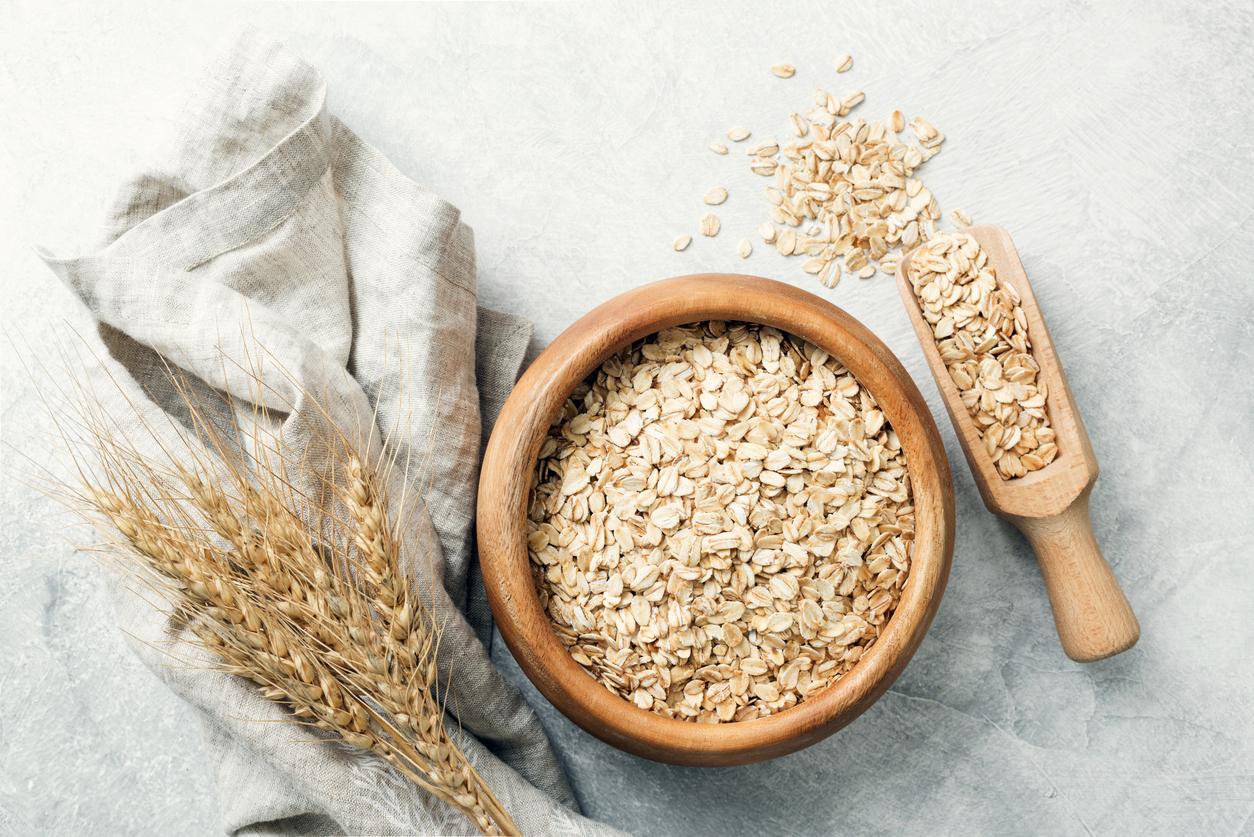What is oat bran?
Oat bran is obtained from the outer husk of the oat grain, called “sound”. When the grains are harvested, they undergo a process of transformation to remove this fibrous envelope and thus obtain oat bran.
To obtain a quality oat bran, the grains are cleaned, hulled and sieved in order to separate the bran from the rest of the cereal. This process retains the rich and beneficial fibers contained in the bran while removing other unwanted parts.
Once obtained, oat bran can be eaten as is, added to various culinary preparations or used as an ingredient in food products such as cereal bars, cookies or breads.
Where to find it?
Since oats are a resilient and adaptable plant, they are grown in many countries, notably in the United States, in Europe (in France, in Germany and in Scandinavia), in Canada and in Australia. This wide geographic distribution allows easy sourcing of oat bran for consumers around the world.
In France, you can buy oat bran in the supermarket, in the cereal section, in bulk products or in the organic products section. It can also be found at health food stores, specialty bulk stores, many online grocery stores, and some farmers’ markets. Be careful not to confuse it with oat flakes: they are two distinct products.
Nutritional values
Oat bran is an extremely nutritious food, rich in various elements beneficial to health. Here are his nutritional values for a portion of 100 gramsaccording to the Ciqual table of ANSES:
- Calories: 359 calories
- Carbohydrates: 51g
- Protein: 15.8g
- Fiber: 16.7g
- Lipids: 6.5g
- Iron: 5.4mg
- Magnesium: 235mg
- Phosphorus: 627 mg
- Calcium: 62.6mg
- Vitamin B1 (thiamin): 1.17 mg
- Vitamin B3 (niacin): 0.93 mg
- Vitamin B5: 1.49mg
THE soluble and insoluble fiber contained in oat bran make it an excellent source of dietary fibre. They promote healthy digestion, help regulate intestinal transit and help maintain healthy cholesterol levels. Oat bran is also valued for its vegetable proteins good quality, making it an attractive choice for vegetarians and vegans.
Due to its richness in minerals such as iron, magnesium, and phosphorus, oat bran also contributes to bone health, energy production, and optimal functioning of the nervous system.
Health benefits
Oat bran offers many health benefits, which are achieved by including it in a varied and balanced diet. Here are some of the most notable benefits…
Improved digestion
Oat bran is rich in dietary fiber, especially soluble fiber. These fibers help regulate intestinal transit, prevent constipation and promote regular digestion.
weight control
The soluble fibers present in oat bran have the ability to form a viscous gel in the stomach, which provides a long-lasting feeling of satiety. It can help curb food cravings, control appetite, and support weight management.
Maintaining healthy cholesterol levels
Oat bran contains soluble fiber called beta-glucans which are known for their ability to lower LDL cholesterol, also known as “bad cholesterol”. By including oat bran in your diet, you can help maintain healthy cholesterol levels.
Blood sugar stabilization
The soluble fiber in oat bran can help slow the absorption of carbohydrates, which leads to a slower release of glucose into the blood. This helps keep blood sugar levels stable and may be beneficial for people with diabetes or those looking to prevent this disease.
Source of essential nutrients
Oat bran is an excellent source of essential nutrients such as iron, magnesium, vitamins B1 and B3, as well as many other minerals. These nutrients are important for proper body function, including energy production, bone health, and nervous system function.
Oat bran does not contain gluten
Oat bran itself does not contain gluten, which is good to know for people who are sensitive or intolerant to it. However, it is important to note that there is a risk of cross contamination when producing, transporting or processing oat bran. This is because oats are often grown and processed near other gluten-containing grains, such as wheat, barley and rye. If you have celiac disease, read the label carefully to check for contamination from other grains.
Benefits for the line
As explained in the introduction, oat bran is the outer covering of the oat grain. Extremely rich in soluble fiber and pectin, it can absorb up to thirty times its volume in water. Its consumption during meals allows its fibers to dissolve and thus mix with food and gel it.
THE bran fibers Unable to be assimilated by the human body, they will cross the colon accompanied by the foods that they have gelled, and all of them will end up in the stool. In fact, by allowing the body to eliminate all or part of the fats and sugars of the meal, oat bran lowers the number of calories ingested and thus becomes a very valuable slimming ally over time. To see a real calorie saving, you must nevertheless consume it regularly.
Furthermore, since soluble fibers form a viscous gel in the stomach, they increase the feeling of satiety and reduce cravings. A real appetite suppressant!
Finally, by stimulating intestinal transit and promoting the digestion of food, oat bran contributes to avoid bloating likely to inflate the belly, as well as water retention. Which can help you feel lighter and look slimmer.
>> Also to discover: the worst fat-storing foods
How to consume it?
Dosage: how much oat bran to consume?
To take advantage of its slimming effects, start with one teaspoon a day. Then gradually increase to one, then two, then three tablespoons daily. Note: it is generally advisable to do not exceed 3 tablespoons per day, in order to avoid intestinal discomfort that could be caused by excessive consumption of bran. But also, to avoid a “leakage” of the vitamin D and magnesium what you need to be fit.
How to taste it?
Oat bran can be consumed in different ways. Here are some suggestions for easily incorporating it into your diet:
- mix it into your breakfast cereal or porridge;
- incorporate it into your smoothies;
- sprinkle it on salads or raw vegetables;
- add it to your dairy products (cottage cheese, yoghurt, glass of milk).
In addition, its exceptional properties remain unchanged during cooking; it is therefore possible to integrate oat bran into your cooking and baking recipes. You can substitute some of the flour with oat bran in your recipes for muffins, cookies, galettes, crepes, pancakes, bread doughPizza dough…
>> To discover also: more slimness with the slimming program Diet care
Side effects
Although oat bran has many health benefits, it can also have some side effects in some people.
Digestive disorders
Oat bran is high in fiber, which can cause bloatingof the gas or a increased stool frequency in some people. Its consumption can be quite poorly tolerated if you have a fragile colon or if you have undergone an operation on the abdomen or the digestive tract. In this case, talk to your doctor before including oat bran in your daily regimen.
In general, it is recommended to start with small amounts of oat bran and increase gradually to allow your digestive system to adapt. It is also essential to drink enough water throughout the day. to promote healthy fiber digestion.
Less good assimilation of nutrients
The ability of oat bran to reduce the absorption of fats and sugars also allows it to reduce the absorption of vitamins and other nutrients. If you consume it regularly, it is therefore advisable to take a vitamin supplement outside of meals. However, always consult a healthcare professional before taking any dietary supplements.
Allergic reactions
Although oat bran allergies are rare, some people may be sensitive to this cereal. If you experience allergy symptoms such as itching, rashes, difficulty breathing, or swelling, it is important to seek medical attention.
Drugs interactions
Oat bran can potentially interfere with the absorption of certain medications. If you take medication regularly, it is recommended that you consult your doctor or pharmacist before significantly incorporating oat bran into your diet.
Gluten cross-contamination
Although oat bran itself does not contain gluten, it can be contaminated with gluten during production, transport or processing. This can be problematic for people with celiac disease or gluten sensitivity. It is therefore important to choose certified gluten-free oat bran if you follow a strict gluten-free diet.


















